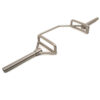Our handy glossary explains the meanings of common health and fitness terms.
A
B
Balance
Balance refers to a person’s ability to maintain their centre of gravity within a base of support.
For example, if a person can stand upright on one leg with no visible sway from side-to-side, then you could say they are demonstrating good balance.
In contrast, an example of poor balance would be a person attempting to balance on one leg, swaying significantly from side-to-side and quickly planting their other foot to prevent them falling.
The base of support is all contact points with the surface beneath the person. This could include parts of the body, such as feet or hands, or objects such as a walking stick.
Balance can be assessed for static positions, such as standing, or for dynamic movements, such as walking.
Balance training
Balance training refers to planned, structured movements or static positions undertaken for the purpose of maintaining or improving a person’s balance.
Basal metabolic rate (BMR) / metabolism
Basal metabolic rate (BMR), often referred to as metabolism, is the amount of energy expended by a person in a physical and psychological state of rest. It is a measure of the energy required to sustain life and normal bodily functions (known as homeostasis), such as breathing and thermoregulation (controlling body temperature).
Bodybuilding / bodybuilder
Bodybuilding is a popular form of exercise and a competitive sport. The principle aim of bodybuilding is to develop an aesthetically pleasing body composition with increased muscle mass and decreased adipose tissue (body fat).
Two of the key methods employed by bodybuilders to develop their body composition are:
- resistance training (namely weight training); and
- specialised diets that are more favourable for increasing muscle mass and decreasing body fat.
Bodybuilding is categorised as a strength sport, due to its significant focus on resistance training and muscular development.
Bodybuilding competitions involve judging panels that make aesthetic appraisals of the competitor’s body composition, with a key focus on muscular development. Judges consider a range of factors, such as posing technique, muscle size and symmetry.
Body mass index (BMI)
Body mass index, often abbreviated as BMI, is a method for determining whether an individual is in a healthy weight range for their height.
For more information, see our handy guide and BMI calculator.
C
Calisthenics
Calisthenics is a type of exercise that is performed with little or no equipment, primarily making use of the participant’s own bodyweight for resistance.
Common bodyweight exercises, such as push-ups, pull-ups, chin-ups and dips are all classified as calisthenics exercises.
Calorie / calories
Calories are units of energy. They are an indication of how much energy an individual will get from consuming a particular food or drink.
In Australia, we use a different measurement for this: kilojoules.
Even though calories are not the standard measure in Australia, the terms are often used interchangeably in conversation. This is due to the use of calories as the standard measure in countries such as the United States of America.
Compound exercises
Compound exercises involve multiple joints and work more than one muscle group.
Common examples of compound exercises include:
- deadlifts;
- push-ups; and
- squats.
Concentric muscle contraction
Concentric muscle contraction occurs when a muscle shortens, resulting in movement of part of the body.
For example, when performing a bicep curl with a dumbbell, the bicep muscle shortens bringing the dumbbell towards the shoulder and changing the angle of the elbow joint. During the bicep curl, a concentric muscle contraction occurs as the dumbbell is moved away from the starting position near the leg and up towards the shoulder.
For most movements, concentric contraction results in a change of angle for a hinge joint (such as the elbows or knees) or a ball and socket joint (shoulders or hips). However, concentric muscle contraction does not always involve a single joint. For example, when performing an abdominal crunch, the concentric contraction (which occurs when raising the chest up and towards the legs) results in flexion of the spine (vertebral column), which is comprised of many joints.
Also see related term: eccentric muscle contraction.
CrossFit
CrossFit is a branded fitness program and registered trademark. The trademark is owned by CrossFit, LLC, a limited liability company headquartered in the United States of America. CrossFit, LLC certifies trainers and licenses the CrossFit brand to fitness facilities for a fee.
CrossFit is promoted as a lifestyle of daily exercise and good nutrition.
It has a strong emphasis on variety of exercises. CrossFit workouts are typically different each day and are commonly known as ‘workout of the day’ (WOD or WODs).
CrossFit incorporates exercises from many other types of fitness training and sports, such as:
- calisthenics;
- high-intensity interval training;
- weightlifting (particularly Olympic weightlifting);
- plyometrics;
- powerlifting; and
- strength athletics (strongman/strongwoman).
CrossFit has also become a popular competitive sport, with the CrossFit Games launching in 2007. The winning athletes are described as being the ‘Fittest (Man or Woman) on Earth’.
D
E
Eccentric muscle contraction
Eccentric muscle contraction occurs when a muscle lengthens, resulting in movement of part of the body.
For example, when performing a bicep curl with a dumbbell, an eccentric muscle contraction occurs as the dumbbell is moved away from the shoulder and back down to the starting position near the leg. The eccentric contraction follows the concentric contraction and completes the movement of the bicep curl exercise.
During exercise, weight training in particular, eccentric contraction will often act as a brake after performing a concentric contraction. For example, when performing a bicep curl with a dumbbell, the eccentric muscle contraction allows for a controlled descent of the dumbbell back to the starting position. The same is true of a pull-up, as the body is lowered back to the starting position.
For most movements, eccentric contraction results in a change of angle for a hinge joint (such as the elbows or knees) or a ball and socket joint (shoulders or hips). However, eccentric muscle contraction does not always involve a single joint. For example, when performing an abdominal crunch, the eccentric contraction (which occurs when lowering the chest back down and away from the legs) results in extension of the spine (vertebral column), which is comprised of many joints.
Also see related term: concentric muscle contraction.
Exercise
Planned, structured and repetitive movements carried out to sustain or improve fitness and health.
Also see related term: physical activity.
Source for this definition: Fitness Australia (fitness.org.au).
Exercise professional
A qualified and registered/accredited person who supplies exercise services to the public.
For example, this includes qualified fitness instructors and personal trainers.
Source for this definition: Fitness Australia (fitness.org.au).
F
Free weights
Free weights are a type of weight training equipment that is supported entirely by the participant during each repetition of an exercise.
The weight may be racked (put on hooks, rails or handles) between sets, but during each repetition the participant is supporting and stabilising that weight.
Examples of free weights include: barbells; dumbbells; and kettlebells.
Functional training / functional fitness
Functional training is a form of exercise that involves training the body for activities performed in daily life.
Functional training aims to improve a person’s ability to perform common activities, such as carrying bags of groceries or getting up from a seat.
G
H
Heart rate
Heart rate is the speed of an individual’s heartbeat, measured as the number of beats (contractions of the heart) per minute.
Heart rate is often abbreviated as simply BPM (beats per minute). For example, if your heart rate is 75 beats per minute, it might be written as: 75 BPM.
Also see related term: maximal heart rate.
High-intensity interval training (HIIT)
High-intensity interval training, often abbreviated as HIIT, is a form of interval training which is characterised by alternating between short periods of high intensity exercise and short periods of recovery or low intensity exercise.
One of the aims of this style of training is to reduce the overall time required for each workout. Most HIIT sessions are 45 minutes or less. Popular formats include 45, 30 or 20 minute sessions.
Hypertrophy / muscle hypertrophy
Hypertrophy refers to an organ or tissue increasing in size, due to enlargement of its component cells.
In relation to resistance training and fitness more generally, it is muscle hypertrophy that is of particular interest. Muscle hypertrophy refers to skeletal muscle increasing in size.
I
Interval training
Interval training is a type of fitness training that involves exercising at varying levels of intensity (i.e. low, medium or high) in each session. For example, an interval training session may include walking briskly, then sprinting, then jogging, then walking at a regular pace. Participants might also have short periods of rest to recover between exercises.
Isolation exercises
Isolation exercises involve a single joint and aim to target one muscle group.
Common examples of isolation exercises include:
- bicep curls;
- tricep extensions; and
- leg curls.
J
K
Kilojoule / kilojoules
Kilojoules are units of energy. They are an indication of how much energy an individual will get from consuming a particular food or drink. For example, on the packet of a protein bar the kilojoules will be listed in the nutritional information table.
In Australia, the measurement that we use is kilojoules. Some countries, such as the United States of America, use a different measure: calories. The terms are often used interchangeably in conversation, even though calories are not the standard measure in Australia.
L
M
Maximal heart rate / MHR / HRmax
Maximal heart rate, often abbreviated as MHR or HRmax, is the fastest rate that an individual’s heart is capable of beating.
For more information, see our handy maximal heart rate calculator.
Muscular endurance
Muscular endurance is the ability to repeat or sustain exercise repetitions over a period of time.
Muscular strength / strength
Muscular strength is the amount of force that a muscle or group of muscles can generate in a single maximal effort.
Muscular strength is often measured as a one repetition maximum.
N
O
One repetition maximum / one rep max / 1RM
One repetition maximum refers to the maximum amount of resistance (usually measured as weight) that an individual can generate sufficient force against in order to successfully complete one repetition of an exercise.
For example, an individual may be able to bench press a maximum of 100 kilograms for one repetition, but no more than that. That would make 100 kilograms their current one repetition maximum.
One repetition maximum is a commonly used measure of muscular strength.
For more information, see our handy guide and One Rep Max Calculator.
P
Physical activity
Any bodily movement produced by skeletal muscles that require energy expenditure.
Also see related term: exercise.
Source for this definition: Fitness Australia (fitness.org.au).
Physiotherapist
Physiotherapists diagnose, treat and help patients manage a broad range of health conditions, including: sports injuries; musculoskeletal conditions, such as back pain and osteoarthritis; and chronic health conditions, such as diabetes and obesity.
Physiotherapists must have a qualification that is recognised by the Australian Health Practitioner Regulation Agency (AHPRA) and its National Board, the Physiotherapy Board of Australia. Recognised qualifications include a bachelor, masters or professional doctorate program. Physiotherapists must also have completed supervised practice in a clinical setting.
Physiotherapists are required by Australian law to be registered with the Physiotherapy Board of Australia.
The Register of practitioners can be used to determine if a practitioner is registered and able to practice within the scope of their registration. There are also lists of cancelled practitioners and practitioners that have given an undertaking to give up their registration and not practise.
Also see related term: physiotherapy.
Physiotherapy
Physiotherapy uses physical techniques on patients with the aim of improving movement ability, reducing pain, expediting recovery and increasing quality of life.
Techniques used by physiotherapists can include: exercise prescription; manipulation of joints; massage; and stretching.
Also see related term: physiotherapist.
Plyometrics
Plyometrics (or simply plyos) is a type of exercise that aims to improve both strength and speed (power).
Plyometrics is sometimes called jump training; however, it should be noted that plyometrics is not restricted to only jumping-based exercises, even though they are the most common plyometrics exercises.
A concentric contraction performed immediately after an eccentric contraction can produce greater force than a concentric contraction performed alone. This concept is known as stretch-shortening and is fundamental to plyometrics.
To take advantage of this elastic energy, the concentric contraction must occur immediately after the eccentric contraction.
For example, when performing a jump squat:
- the participant starts the exercise by squatting down from a standing position (eccentric contraction of the quadriceps femoris group of muscles);
- they then jump explosively out of the squat position (concentric contraction of the quadriceps);
- after landing from the jump the participant squats down immediately to perform the next repetition; and
- so on until they complete their set.
Power
The term power refers to a combination of strength and speed.
Power could also be described as explosive strength; that is, a person’s ability to generate maximal force in minimal time.
Powerlifting
Powerlifting is a sport in which participants perform weight training exercises, commonly referred to as lifts, using the heaviest weight they can. The standard lifts for competitions (often called meets) are the squat, bench press and deadlift; typically performed in that order. A barbell is used for all of the lifts.
Some competitions (or meets) will diverge from the standard three lifts. For example, some will focus on one lift only, such as the bench press.
Pronation / pronate / pronated
The term pronation can be used in reference to the forearms or feet; however, it’s most commonly used in reference to the forearms.
Pronation occurs when the forearm and palm are rotated inwards. Pronation of the foot refers to turning of the sole outwards, with the weight of the body borne by the medial (inside) part of the foot.
Using the standard anatomical position, pronation of the forearm is when the palm of the hand is rotated inwards, to face posteriorly (to the back).
In reference to weightlifting and calisthenics, a pronated grip is often referred to as an ‘overhand grip’.
Example sentences using the term:
- Bench presses are generally performed using a pronated grip.
- Pull-ups are generally performed using a pronated grip.
Q
R
Repetitions / repetition / reps / rep
In the context of exercise, repetitions refer to the number of times that an exercise movement is performed successfully, from start to finish.
For example, performing five push-ups would mean that five repetitions were achieved.
The singular form of the term is repetition. For example if one push-up was performed, it would mean that one repetition was achieved.
The term is often abbreviated as ‘reps’ (plural form) or ‘rep’ (singular form).
Resistance training
Resistance training is a form of exercise that requires muscles to overcome a resistive force, such as a heavy weight, in order to complete one or more repetitions.
Resistance training is often referred to as strength training or weight training.
S
Standard anatomical position
The standard anatomical position defines a fixed position for the human body, including the upper and lower limbs. It is used as a standard reference point for human anatomy.
The standard anatomical position is an important baseline reference in fields such as medicine and sports science, as practitioners can refer to a specific area of the human body, without needing to also explain the position of the body.
The standard anatomical position for the body is standing upright and facing forward (towards the observer), with arms to the side of the body and palms facing forward.

Image credit: Osteomyoamare, Wikimedia Commons.
Strength sports
Strength sports is a category of sports comprising athletes that focus on strength training in preparation for competition. Competitions involve tests of strength; or in the case of bodybuilding, aesthetic appraisal of an athlete’s muscular development.
The list of strength sports is ever growing, as new fields gain sufficient popularity to support competitive events. As at July 2020, the strength sports category would typically include the following sports:
- bodybuilding;
- grip strength;
- kettlebell lifting;
- olympic weightlifting;
- powerlifting;
- stone lifting; and
- strength athletics (more commonly known as ‘strongman’).
Strength training
Strength training is a form of resistance training which is focussed on building muscular strength.
Strongman / strongwoman / strength athletics
Strength athletics is the gender-neutral name of the sport more commonly referred to as ‘strongman’.
Strongman competitions involve tests of strength that can be quite different to the standard movements in other strength sports, such as bodybuilding or Olympic weightlifting. Strongman competitions vary, but can includes events such as: tire flipping (large truck tires); lifting large stones (often called Atlas Stones); and deadlifting large objects, such as cars.
The World’s Strongest Man and the Arnold Strongman Classic are the two most famous strongman competitions. Both events are held annually and attract athletes from all across the globe.
Many smaller competitions that include both male and female events are still named as ‘strongman’ competitions. However, there are a growing number of strongwoman competitions specifically for female athletes. For example, this includes the Arnold Pro Strongwoman event that has been held annually since 2017.
Supination / supinate / supinated
The term supination can be used in reference to the forearms or feet; however, it’s most commonly used in reference to the forearms.
Supination occurs when the forearm and palm are rotated outwards. Supination of the foot refers to turning of the sole inwards, with the weight of the body borne by the lateral (outside) edge of the foot.
Using the standard anatomical position, supination of the forearm is when the palm of the hand is facing anteriorly (to the front). The standard anatomical position has the forearms supinated.
In reference to weightlifting and calisthenics, a supinated grip is often referred to as an ‘underhand grip’.
Example sentences using the term:
- Chin-ups are generally performed using a supinated grip.
- Bicep curls generally involve supination of the forearm; however, hammer curls do not.
T
U
V
W
Weight machines / cable machines
Weight machines are a type of weight training equipment. They typically use weight stacks with a cable and pulley system.
Unlike free weights, when using a weight machine, the exercise participant is not required to wholly support the stability of the weight throughout each repetition. This means that stabiliser muscles are not required to work as much when using a weight machine. It also means that the same type of exercise will usually be easier on a weight machine than it would be using free weights.
For example, an overhead shoulder press will typically be much easier to perform using a shoulder press machine than it would be using a dumbbell of the same weight (that is, the same as the weight selected on the shoulder press machine).
Weight training / weightlifting
Weight training is a form of strength training that uses weight as a resisting force that muscles need to overcome when performing exercises.
Common weight training equipment includes free weights and weight machines.










